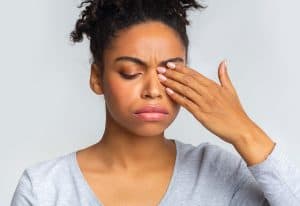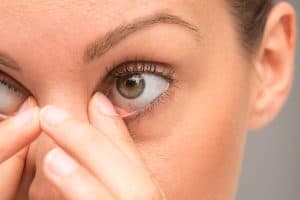
A stye (hordeolum) and a chalazion are common eye conditions that can cause discomfort and irritation. While they may seem similar, they have distinct differences. A stye is a red, painful lump near the edge of the eyelid, often caused by a bacterial infection in the oil glands of the eyelid. On the other hand, a chalazion is a painless lump or swelling that develops when an oil gland in the eyelid becomes blocked.
At the Laser Eye Center, we put your eye health and comfort first. Here’s a comprehensive guide on how to treat a stye or chalazion and prevent future occurrences.
Recognizing the Symptoms
Symptoms of a Stye
- Redness and Swelling: The eyelid may appear red and swollen, and the affected area is typically tender to the touch.
- Pain: A stye often causes significant discomfort and can make blinking painful.
- Tearing: Excessive tearing is a common symptom as the eye tries to wash out the infection.
- Crust Formation: The stye may ooze pus, leading to crust formation on the eyelid margin.
Symptoms of a Chalazion
- Painless Lump: Unlike a stye, a chalazion usually doesn’t hurt but presents as a firm lump on the eyelid.
- Swelling: The swelling can increase gradually over a few weeks.
- Blurred Vision: If a chalazion grows large enough, it can press on the eyeball, causing blurry vision.
- Mild Irritation: Some individuals may experience mild irritation or a feeling of heaviness in the eyelid.
Treatment Options
Home Remedies
For both styes and chalazia, there are several home remedies that can provide relief and promote healing:
Warm Compress
Applying a warm compress to the affected eyelid helps in reducing inflammation and encourages drainage of the blocked gland. Follow these steps:
- Soak a clean washcloth in warm water.
- Wring out the excess water.
- Place the warm cloth over the closed eyelid for 10-15 minutes.
- Repeat this process 3-4 times a day until the stye or chalazion improves.
Eyelid Hygiene
Maintaining proper eyelid hygiene is crucial:
- Gently cleanse your eyelids with a mild, tear-free baby shampoo mixed with water.
- Use a clean cotton swab or a soft cloth to apply the solution.
- Rinse with warm water and pat dry with a clean towel.
Avoid Squeezing
It might be tempting to squeeze a stye or chalazion, but this can worsen the infection or cause further complications. Allow it to drain naturally.
Over-the-Counter Treatments
Several over-the-counter treatments can help manage symptoms:
- Pain Relief: Use over-the-counter pain relievers like ibuprofen or acetaminophen to reduce pain and inflammation.
- Antibiotic Ointments: Topical antibiotic ointments, available without a prescription, can help fight bacterial infections associated with styes.
Medical Treatments
If home remedies and over-the-counter treatments are not effective, it’s important to seek medical attention. At the Laser Eye Center, we offer several professional treatments:
Prescription Medications
Your doctor may prescribe antibiotics in the form of ointments, drops, or oral medication to treat bacterial infections.
Steroid Injections
For chalazia, steroid injections can be administered to reduce inflammation and shrink the lump.
Incision and Drainage
In cases where a stye or chalazion does not resolve on its own, a minor surgical procedure may be required. This involves making a small incision to drain the contents. The procedure is quick, often performed under local anesthesia, and provides immediate relief.
Laser Therapy
Laser treatment is an effective option for persistent chalazia. It targets the blocked gland and promotes healing with minimal discomfort and downtime.
Preventing Future Styes and Chalazia

Preventative measures are key to avoiding recurrence:
Proper Eyelid Hygiene
Clean your eyelids regularly, especially if you have a history of styes or chalazia. Removing makeup before bed and avoiding the use of expired cosmetics can also reduce the risk.
Managing Blepharitis
Blepharitis, a chronic inflammation of the eyelid, can predispose individuals to styes and chalazia. Managing this condition with regular eyelid hygiene and prescribed treatments can help prevent these issues.
Avoid Touching Your Eyes
Keep your hands clean and avoid touching your eyes, as bacteria can easily transfer from your hands to your eyelids.
Healthy Diet and Hydration
Maintaining a healthy diet and staying hydrated supports overall eye health. Omega-3 fatty acids, found in fish oil, flaxseeds, and walnuts, can be particularly beneficial for maintaining the health of the oil glands in your eyelids.
Regular Eye Exams
Regular check-ups with your eye care professional at the Laser Eye Center can help identify potential issues early and provide guidance on maintaining optimal eye health.
Dealing with Recurrence
Despite taking preventive measures, some people may still experience recurring styes or chalazia. In such cases, it’s important to consider underlying factors that might be contributing to the recurrence. Conditions like rosacea, seborrheic dermatitis, or meibomian gland dysfunction can increase the risk. Discussing these possibilities with your healthcare provider can help in tailoring a more effective long-term prevention strategy.
Importance of a Healthy Lifestyle
A holistic approach to eye health involves maintaining a balanced lifestyle. Here are some additional tips to support your eye health:
Stress Management
Chronic stress can weaken your immune system, making you more susceptible to infections. Practice stress-relief techniques such as yoga, meditation, or deep-breathing exercises to maintain your overall well-being.
Sleep Hygiene
Adequate sleep is essential for maintaining a healthy immune system. Ensure you get 7-9 hours of quality sleep each night. A proper sleep routine can help your body fight off infections more effectively.
Proper Nutrition
Incorporate a variety of fruits and vegetables into your diet to ensure you’re getting essential vitamins and minerals that support eye health. Vitamins A, C, and E, along with zinc, are particularly important for maintaining good vision and eye health.
Hydration
Drinking enough water is crucial for maintaining the health of your entire body, including your eyes. Dehydration can lead to dry eyes and other complications, so aim to drink at least eight glasses of water a day.
When to Seek Professional Help
While many styes and chalazia resolve on their own, persistent or recurrent cases require professional attention. At the Laser Eye Center, we offer comprehensive care tailored to your needs. Our experienced team is dedicated to ensuring your comfort and health through personalized treatment plans.
If you experience any of the following, it’s time to seek medical help:
- Persistent Swelling: If the lump doesn’t reduce in size or continues to grow.
- Increased Pain: If the pain intensifies despite home treatments.
- Vision Changes: Blurred vision or any changes in vision should be addressed immediately.
- Recurring Infections: Frequent styes or chalazia could indicate an underlying issue that needs medical evaluation.
Take the Next Step Towards Healthy Eyes
If you’re dealing with a stye or chalazion, or have concerns about your eye health, don’t hesitate to reach out to the Laser Eye Center. Our experts are here to provide the care and support you need. Schedule an appointment today to experience healthier, more comfortable eyes.
Schedule your free consult today
Click here to learn moreGet started on your journey to clearer, crisper vision with Laser Eye Center™. Our expert team of doctors are trained and skilled in the latest technology and methods for laser vision correction. To learn more about our state-of-the-art All Laser LASIK technology or about All Laser LASIK itself, contact us today. Schedule your FREE All Laser LASIK consultation by calling today.

